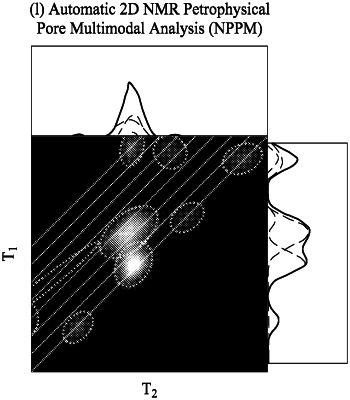| CPC E21B 49/088 (2013.01) [E21B 7/046 (2013.01); E21B 49/02 (2013.01); E21B 49/0875 (2020.05); G01N 15/088 (2013.01); G01N 24/081 (2013.01); G01N 24/082 (2013.01); G01N 33/241 (2013.01); G01R 33/50 (2013.01); G01V 3/32 (2013.01); G01V 3/38 (2013.01); G01N 2015/0846 (2013.01)] | 20 Claims |

|
1. A method of improving production of hydrocarbons from a subsurface region, comprising:
identifying modes in nuclear magnetic resonance (NMR) longitudinal relaxation time (T1)-transverse relaxation time(T2) data from a plurality of samples;
assigning the modes to a poro-fluid class;
clustering the modes based on poro-fluid class to produce a plurality of clusters, wherein each cluster represents one or more poro-fluid classes;
estimating a bulk fluid relaxation time (estimated TB) based on an asymptote fit of the clusters, wherein the asymptote is based on T1 and T2 relaxation mechanisms in a bulk fluid relaxation-dominated limit;
estimating a ratio of a transverse T2 pore surface relaxivity constant (ρ2) to a longitudinal T1 pore surface relaxivity constant (ρ1), the ratio represented as ρ2/ρ1, based on an asymptote fit of the clusters, wherein the asymptote is based on T1 and T2 relaxation mechanisms in a surface relaxation-dominated limit;
fitting the T1 relaxation mechanisms and the T2 relaxation mechanisms to one or more of the clusters using the estimated TB;
deriving at least one pore or fluid relaxation parameter and endpoint for the poro-fluid classes from the fit, wherein the at least one pore or fluid relaxation parameter and endpoint is selected from the group consisting of ρ1, ρ2, a pore surface-to-volume ratio (A/V), an equivalent pore-throat radius (req), and a bulk fluid relaxation time (TB); and
identifying potential hydrocarbon-bearing formations in the subsurface region based on the derived at least one pore or fluid relaxation parameter and endpoint for the poro-fluid classes.
|